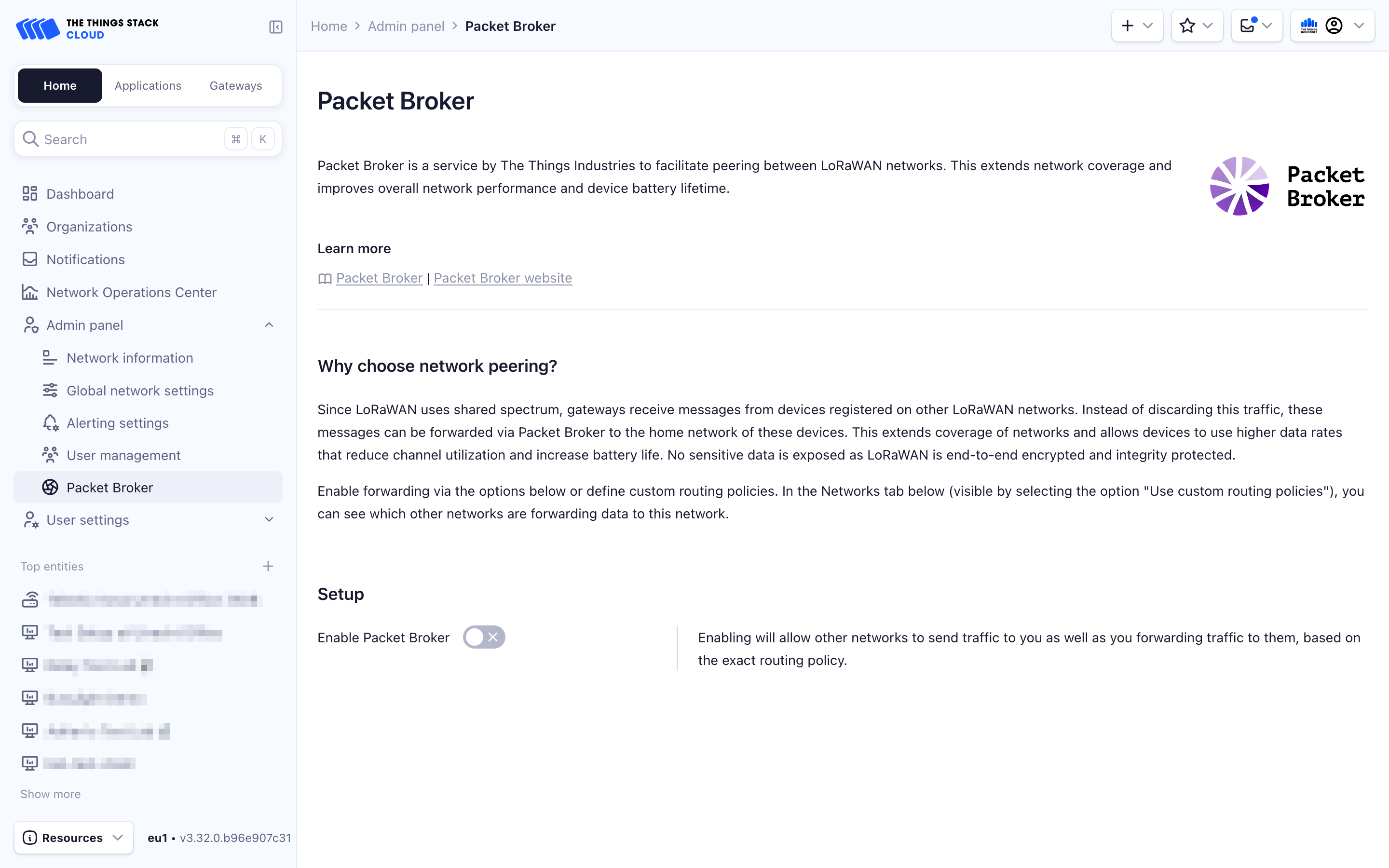This section shows you how to configure Packet Broker. You can manage your registration, list other networks, configure routing policies with other networks, and see which networks are forwarding traffic to your network.
To see which routing policies are configured by default for all deployments, see the Packet Broker Routing section.
Prerequisites
- Understand how Packet Broker works and what routing policies are. Learn about Packet Broker.
- The Things Stack connected to Packet Broker.
-
The Things Stack Cloud is already connected to Packet Broker.
-
The Things Stack Enterprise and Open Source: see Connect.
- An admin account for the The Things Stack deployment. All Packet Broker configuration requires administrative access.
Packet Broker can be configured using either the Console or the CLI.
Configure Packet Broker
To configure Packet Broker, click on Admin panel in the left-hand menu and select Packet Broker.

This will take you to the dedicated Packet Broker configuration page.
Register or Deregister Tenant
Before configuring routing policies, you must first register your tenant with Packet Broker. To register it, toggle the Register network switch and make sure that Forwarder and Home network are enabled.

Note:
Deregistering from Packet Broker will delete any routing policies associated with a tenant. Security settings may disable deregistering a network from Packet Broker.Network Visibility
To publicly list your tenant, enable the List network publicly switch. This will allow other networks to easily find and configure routing policies with your network.

View Registration
To view the current registration with Packet Broker:
ttn-lw-cli packetbroker info
Example output with registration
{
"registration": {
"id": {
"net_id": 19,
"tenant_id": "my-company"
},
"name": "My Company",
"dev_addr_blocks": [
{
"dev_addr_prefix": {
"dev_addr": "27ABCD00",
"length": 24
}
}
],
"contact_info": [
{
"contact_method": "CONTACT_METHOD_EMAIL",
"value": "admin@example.com"
},
{
"contact_type": "CONTACT_TYPE_TECHNICAL",
"contact_method": "CONTACT_METHOD_EMAIL",
"value": "tech@example.com"
}
]
},
"forwarder_enabled": true,
"home_network_enabled": true
}
Example output without registration
{
"forwarder_enabled": true,
"home_network_enabled": true
}
Register Tenant
Note:
You can register with Packet Broker if you are a tenant. This is the case for all users of The Things Stack Cloud and in other deployments where you are using a hostNetID. If you are using your own NetID without tenancy, please reach out to join@packetbroker.net for registration.
To register or update your existing tenant registration:
ttn-lw-cli packetbroker register --listed
This updates the registration with Packet Broker based on your The Things Stack environment. When using The Things Stack Cloud, the registration is based on your subscription. When using The Things Stack Enterprise or Open Source, the registration is based on your configuration.
With --listed, you make your network publicly listed so it can be found by other network administrators. This flag is optional.
Deregister Tenant
Warning:
This permanently deletes all routing policies that you configured as Forwarder to other Home Networks. It also permanently deletes all routing policies configured by other Forwarders for you as Home Network.To deregister from Packet Broker:
ttn-lw-cli packetbroker deregister
